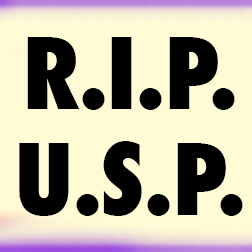“Differentiate or Die” is Dead.
Before we cremate our dear departed Differentiate, brothers and sisters, let’s revisit history:
A few decades ago, “Differentiate or Die” was everywhere. The slogan was the popular successor to “USP” (Unique Selling Proposition), an ad strategy rooted in the 1950s, well before the Bernbach-inspired “Creative Revolution” of the 1960s.
USP had its run, and still has a few uncritical (if not naive) adherents today, because it makes a bit of logical sense on first inspection. If consumers are going to buy your goods/services/title/candidate/widget, you must give them a reason that is unduplicated, credible, and clear. U, S, and P. Game, set, match.
This worked well in a world of TV audiences watching a limited number of stations, willing to sit passively (no remote controls!) through 60- and even 90-second spots that hammered the hard sell home. Magazine readers would patiently peruse long-copy ads, unsubtle sermons about secret ingredients, 4-out-of-5 doctors, and other “rational” appeals.
But the USP usually represented what advertisers said, not what audiences heard. “Differentiate or Die” gained popularity in the ’60s and ’70s because it focused on what happened in the minds of consumers. Aha! Hertz and Avis are not identical: spunky little Avis Tries Harder! Parliament cigarettes have a recessed filter! I hate waxy yellow build-up!
This, too, sounds like a reasonable sales strategy, and it sold a ton of books, so why are we standing here at the graveside? Isn’t Differentiate as important a value as ever? Don’t we demand a good, solid, left-brain Reason to justify our purchase?
Sadly, my fellow mourners, it’s time to dispatch the big D. It had a good run, too, but it got bumped off. Cause of death: diminished relevance. Can I get an Amen?
Let us go then, you and I, to make a purchase so we can see how consumer decision-making behavior has adapted and evolved. Let’s say you get a hankering for a (blowtorch/Mexican vacation/Punjabi restaurant) but you’ve never bought one before. If you’re over 80, you turn to the Yellow Pages. The rest of us fire up Google or Yahoo or Yelp or YouTube. You find multiple sources of (blowtorches, vacations, etc.) even on the first page of Google results. After a brief survey of the page (you do not go past page one, naturally) maybe two or three listings strike a chord, seeming to offer what you want. You select the most appealing one to open, and discover the vendor is nearby, open on Sunday, seems to be all about Punjabi food or blowtorches, and … and … the search is over. Done.
Of course, you might not be totally satisfied with choice #1, so you go back to inspect #2. It happens. But it’s obvious that for choice #5 to succeed, four others will have to fail. You have many more choices than ever, and less time. Everybody has more choices and less time. Everybody feels empowered to find what they need, just as they turn a deaf ear to your ads, brochures and phone calls attempting to tell them what they need. They like to buy; they don’t like to be sold to; they refuse to read your ten-reasons-why. These are the short-attention spaniels.
So here’s the point: choice #3 may be an objectively better choice (whatever that means), highly differentiated from choice #2 that actually connected and made the sale. More convenient/lower prices/better selection/more helpful staff/more colorful widgets. Whatever. But what does that differentiation, being “better,” matter if it never gets seen? The “inferior” product may make the sale, because the superior service/book/candidate never came into play, and sank into the depths with bubbling groan.
The landscape is littered with companies that labored mightily to create a better (whiter! brighter! differentiated!) mouse trap, only to learn that the world sometimes doesn’t give a rat’s ass. The world rushes to reward what it perceives as the more visible brand of mouse trap next door. Opinions 1, Facts 0. Again.
Visibility is now more important than differentiation. Mission One: Get into the selection set. Get found.